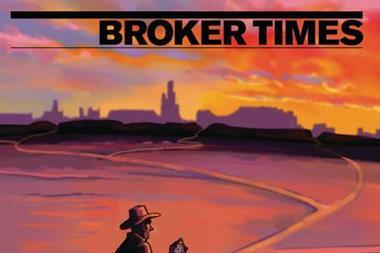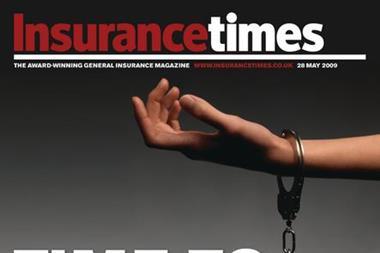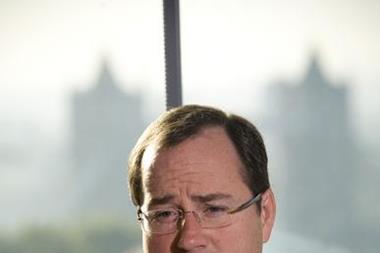The past two years of economic turmoil have damaged leading insurers, and their GWP – and, for some, their place in the ranks of the top 10 – has tumbled. Now, as the UK stutters towards recovery, they’re having to watch their flanks as a new battalion moves in on their territory
As UK plc makes a sluggish return to growth, the fallout of the past two years has led to a shift in market boundaries. In the wake of badly damaged results, the old guard of leading insurers has tried to retrench by cutting commissions, pushing rate increases and retreating from risks. Meanwhile, the second rank has made its move, advancing steadily on the territory of their larger rivals. The result is a new breed of insurers ready to cast off their secondary status and have a crack at the mainstream.
There has never been a better time as the top players continue to suffer. Aviva has seen £1bn wiped off its commercial premium, AXA suffered a 4% fall in revenues to £1.06bn in the first six months of 2009, while the fate of RBS’s general insurance arm continues to be a guessing game.
Elsewhere, Allianz lost its long-held top 10 ranking in Insurance Times’s ‘Top 50 Insurers’ after the gross written premium (GWP) in its retail business dropped 20% to £292.1m.
By contrast, insurers such as Brit, QBE, Fortis, LV=, Amlin, XL Insurance and Chaucer have emerged as the year’s big success stories.
Fortis is at the vanguard, bouncing back from the financial crisis to take on the big guns in commercial lines and seizing control of Tesco’s financial services arm from RBSI. Elsewhere, sitting on the cusp of the top 10 – with a ranking of number 13 – Australian insurer QBE has made no secret of its desire to become a major UK presence. Its acquisition last year of the property specialist firm Evergreen from Munich Re’s Beaufort Underwriting Agency is one more step towards that aim.
The upstarts go up
Brit also has had a good year. After bolstering its public presence by securing sponsorship of the English cricket team, the Lloyd’s insurer reported £1.3bn GWP for the first nine months of last year– an increase of 4.7% compared with the same period in 2008.
Meanwhile, since its management restructure a couple of years ago, LV= has garnered particularly impressive results. After delivering a 92% growth in GWP to £397.5m by the first half of 2009, it has now become a top 20 UK insurer. According to group chief executive John O’Roarke, its GWP for 2009 is likely to stand in excess of £810m.
XL Insurance has also climbed five places to number 14 in the top 50. After a tumultuous period, the insurer regained its strength this year, cutting its net loss from $1.6bn (£98m) to $11.4m (£7m) and has expanded in the UK professional indemnity market. Elsewhere, Amlin and Chaucer increased GWP by 52% to £1.37bn and 23.5% to £650.3m respectively. But as the battle lines for business are redrawn, it remains to be seen whether this growth is set to continue or whether the insurance giants will fight back.
Several factors have played into the hands of the upstarts. As the larger insurers tried to push through rate increases, the economic climate helped the door open for more competition. Lark Insurance group managing director Stephen Lark says that as brokers grapple with the demands of cost-conscious clients, they are more likely to switch allegiance. “There is a natural opportunity there – especially at a time when the economy has driven clients towards the best deal they can get. A 10- or 15-year relationship with RSA doesn’t mean quite so much if there is a 10 or 15% premium saving on the table.”
But smaller insurers also insist service has been a key differentiator, arguing that brokers are fed up with the unwieldy corporate structure of larger insurers. Moorhouse chairman Lyndon Wood explains: “Being smaller, they are able to be more agile when dealing with the broker market. They have a flatter structure so, whereas with a larger insurer you might go through an account executive, then a manager, then an account executive and so on until eventually months on you might get a decision … with a smaller insurer you get answers more quickly.”
Meanwhile, Fortis has 2,300 brokers on its books and is increasing that by 100 a year. Chief executive Barry Smith says the agility of the new breed of insurers is proving attractive. “It is about the capability of the newer organisations to make things happen … It is down to the culture, the team ethos, that ability to make decisions and to take action unencumbered by systems constraints or by acquisitions in the past that are still very painful today.”
LV=’s broker business has exploded from £19.2m for the first half of 2008 to its present value of £400m. O’Roarke says the promise of accessibility has fuelled brokers’ appetite for new players. “If a broker needs something quickly, they can get to an underwriter or a senior manager just by picking up a phone, which is not the case with some of our bigger competitors.” He adds that this promise of better relationships has paid off. “If you look across the market generally, the bigger insurers are losing market share and the smaller ones are gaining it.”
Furthermore, as the marketplace becomes tougher, more brokers are looking to set themselves apart by specialising in niche areas. Cooper Gay’s underwriting and distribution management director Chris Butcher explains that smaller niche insurers are more adept at grappling with current market demands. “They have an ability to understand their area rather than having a broader-brush strategy like Aviva,” he says.
‘A unique edge’
Amlin’s sales and marketing director David Overall says opting to do business with smaller insurers can offers brokers a valued exclusivity. “By focusing on specific lines with specific brokers, we have been able to offer a level of uniqueness that is often missing with the larger composite market’s broker relationships,” he says. “Moreover, it gives the brokers a unique edge with their clients – especially critical with the highly competitive SME and mid-corporate sector clients.”
Regional expansion has also helped to fuel growth. As larger insurers close regional offices to cut costs, smaller players – most noticeably Brit – have attempted to fill the gap. Former Primary chief executive and SSP director Jonathan Davey says that the withdrawal of larger players from the regions has led brokers to switch allegiance to smaller insurers. “A lot of insurers anticipated that, post-FSA, there would be more consolidation and fewer brokers left in the market. That didn’t happen.” He says that this led to a service deficit “where brokers were not looked after by their insurers”.
Brit’s UK distribution director Simon Cooter points out that 30% of Brit’s UK income now comes from the regions. “The brokers want local underwriting teams. They want underwriters within those teams who are experienced, who understand how to run the business and who understand the local markets.”
Elsewhere, global players such as XL Insurance have been able to harness international expertise to pounce on opportunities in the UK market. During 2009, the insurer, which has a UK GWP in excess of £500m, gained a 7% share of the solicitors’ PI market and has expanded in casualty and rehab markets. It is also extending its focus from top-end corporate business to mid-market FTSE 2000 clients.
“We look for specific opportunities … bringing our expertise that we have built up in either another country or with larger clients to a new sector,” UK country manager Donal Kelly says.
Determined to make the top 10
So what does the future hold? Smith and Cooter make little secret for their plans to scale the top 10. “Why wouldn’t we be (in the top 10)? In our chosen market we are creating significant capability and capacity as we speak,” is Smith’s assertive response. Meanwhile, Cooter has set a timeframe: “In five years’ time when brokers are talking about the main UK commercial insurers, I would expect to see Brit as a name in the top 10.”
Kelly is more cautious. “We are always looking to bring our expertise to new areas if we can. For us it is about where we can achieve good return for the capital we can employ. Our focus is not to get to the top 10.” But he adds: “If we continue to write business at the level we are at the moment, and if we continue to expand into new areas and bring the expertise from the top end of the market to the next level down, you can expect that it will happen over time.”
But the big guys show little sign of rolling over quietly. Aviva has been especially keen to regain the favour of the consolidators and win back business. Consequently, Lark believes the rush towards rate increases has stalled once again. “There is greater flexibility over pricing than there has been. I think there is more of a focus on business retention than 12 months ago.”
However, some sources – especially from the MGA quarter – believe the heyday of the big insurers is on the wane. “Aviva and the others are going to be particularly under threat. The more adaptable, smaller player has more opportunities than a large organisation that is encumbered.
“It goes back to that old supertanker argument – it will be difficult for them to change direction,” Butcher argues.
Penetration may ‘prove difficult’
Davey adds that some of the major players are unlikely to be able to hold off on rate increases for long.
“Most of those markets have already raked and pillaged their reserves and now have no choice but to write business at an underwriting profit,” he says. “The days of cash flow underwriting are gone. I can’t see how those markets can get that business back unless they fundamentally change their proposition.”
But despite riding on a wave of success, smaller insurers may find that further market penetration may prove more difficult than hoped. Wood says that while there has been a greater trend for smaller insurers looking to join brokers’ panels, more of these overtures may be rebuffed. “Many established brokers will already have their panel … another mouth to feed can be a bit too much. They have their work cut out for them still. It is not all plain sailing in the markets in terms of recruiting their teams and opening up some new doors.”
However, Cooter believes the stage is primed for an upheaval at the top. “Over the next three to five years, I believe that one or two insurers will emerge and become significant players in their own right. That definitely will be partly at the expense of some of the bigger insurers that have that business today.”
It seems that only one thing is certain: the new breed may have won the battle but the old guard won’t stand aside without a fight. IT





































No comments yet